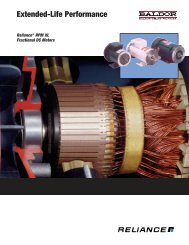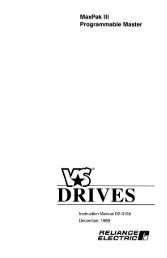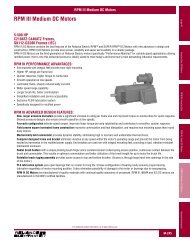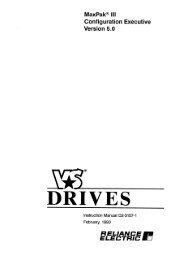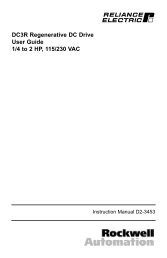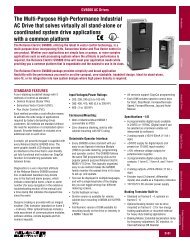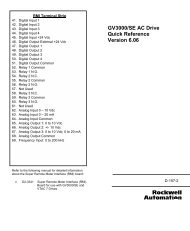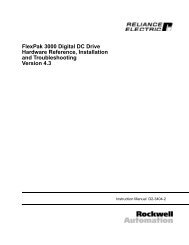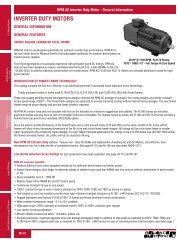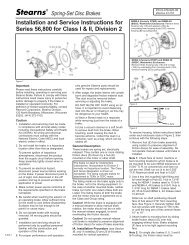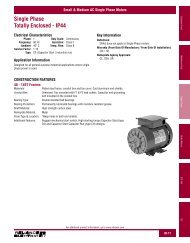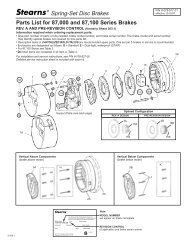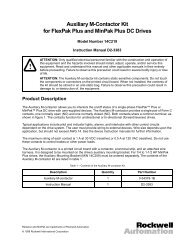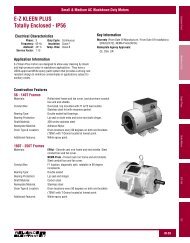D-3836 - Reliance Electric
D-3836 - Reliance Electric
D-3836 - Reliance Electric
You also want an ePaper? Increase the reach of your titles
YUMPU automatically turns print PDFs into web optimized ePapers that Google loves.
★1
1.0 General – This manual familiarizes the user with<strong>Reliance</strong> <strong>Electric</strong> Company’s ImPak Plus D-C V★Sdrive controller. It should be read before performing installationor start-up.Before working on, or operating, the controller, it is necessaryto keep certain Warnings and Cautions in mind. 2.0 General – The ImPak Plus D-C V★S drive controllermay be applied to single-phase d-c drive applications withinthe following ratings: From 1/4 to 3/4 hp with a 115 VAC, 50/60 Hz input voltage From 1 to 3 hp with a 230 VAC, 50/60 Hz input voltageThe controller provides power-conversion and control circuitswhich convert the a-c line voltage into adjustable d-cvoltage in order to effectively control the drive motor.The ImPak Plus controller enclosure is classified asNEMA Type 4/12. The controller and its Kits are UnderwritersLaboratories (U.L.) listed and Canadian StandardsAssociation (C.S.A.) certified.2.1 Operator Control Station – The Operator ControlStation contains the following controls as standard: POWER ON/OFF circuit breaker SPEED control potentiometer START/STOP selector switchIn addition to the above, the ImPak PIus model with reversingcapability contains, as standard, a FORWARD/REVERSE switch and an internal Dynamic Braking resistor.The dynamic braking capability is not a mechanical holdingbrake. It will not hold the shaft in place, nor will it preventthe motor from turning once motion has stopped.Also note that the resistor is sized for infrequent stops.Thus users must allow time between stops for dissipationof heat.2.2 D-C Drive Motor – Along with the controller, a d-cdrive motor is used to complete the drive system. Permanentmagnetic motors may be used up to 1-1/2 hp. Woundfield (excited) motors may be used up to 3 hp.Section 1INTRODUCTIONSection 2CONTROLLER SPECIFICATIONS <strong>Reliance</strong> offers a completely power-matched drive systemfor the application. Thus the choice of <strong>Reliance</strong> motors assuresoptimum performance and unmatched singlesourceresponsibility.2.3 Modification Kits – Three Modification Kits, whichextend the basic capability of the ImPak Plus, are available.These are: Double Pole Circuit Breaker Field Supply Minimum/Maximum SpeedComplete descriptions are given in Section 4. (Refer toFigure 2.1.)The Field Supply Kit is standard on 3 hp controllers.2.4 Line Frequency – The ImPak Plus controller can runwithout modification from a single-phase power sourcehaving a frequency range from 48 to 62 Hz. However, foroptimum 50 Hz operation, it is recommended that 2 jumpersbe removed from the Regulator Module. (Completeinstructions are printed on the label fixed to the undersideof the Cover.) If the jumpers are not removed, there is aslight loss of performance.2.5 Voltage Tolerance – The ImPak PIus controller deliversoutput current and voltage, as listed in Table 3.A. It willalso operate within these regulation specifications evenwith incoming line voltage at +10% of nominal. Furthermore,the controller will operate without component damageduring momentary input voltage dips even down to25% of nominal.2.6 Line Impedance Requirements – The standardImPak Plus controller contains a short-circuit protectionsystem designed to operate on plant power supplies withmaximum permissible available symmetrical RMS faultcurrents of either 1000 or 5000 amperes, depending onthe hp rating.Copyright <strong>Reliance</strong> <strong>Electric</strong> Industrial Company, 1991 2<strong>Reliance</strong> and V★S are Trademarks of <strong>Reliance</strong> <strong>Electric</strong> Industrial Company
1. Circuit Breaker2. One of 2 50-Hz jumpers3. Oblong hole4. Nylon guides5. Min./Max. Speed Kitconnects here6. Replacement parts list7. Security lock lip8. Field Supply Kit9. Power Cube10. Plug-in terminals (2) forField Supply wiring11. Terminal barrier; makeincoming and outgoingconnections this side12. This conduit for a-c incomingconductors13. Mounting bolts here14. This conduit for d-coutgoing conductorsNote: leave a 2-inch (50 mm)unobstructed area on all sidesof controller for air circulation.3.0 General – This Section outlines the procedures thatare to be followed in order to properly install an ImPak Pluscontroller.The d-c motor should be installed and wired in accordancewith installation instructions supplied with each drive.When opening the Cover, always lift it about 2 inches (50mm) directly up from the Chassis. Only then swing it toone side. Internal components require this procedure.Observe the 3 Warnings on page 2 of this manual. Also,follow this warning:Section 3INSTALLATION If a 3-conductor incoming a-c line is being used, it is necessaryto connect the GND (green/ground) wire to the terminalprovided in the control. A ring type connector is recommended.The user must be sure that the ground wireis connected to the plant ground at the source.3.1 Mounting – The controller is designed as a wallmountedunit. It should be hung within 10 o of vertical. (Referto Figure 3.1 for mounting dimensions.)3.2 Conductors – Incoming a-c and outgoing d-c conductorsmust be brought into the Chassis through the conduitwells provided. (Refer to Figure 2.1.) Use metal conduitsto maintain the NEMA Type 4/12 rating. Be sure to turn theconnections a minimum of 8 turns. (Do not use the conduitwells located on the bottom of the Chassis.)3
An existing plant branch switch may provide adequateprotection. However, the standard POWER ON/OFF circuitbreaker is a single-pole type designed to provide overcurrentprotection for the internal Power Cube containingthe power semiconductors. It should not be considered amain disconnect device. Also, the optional unfusedDouble Pole Circuit Breaker Kit may not be considered asa substitute. Some local codes may prohibit the openingof the common (white/L2) conductor if one side of the 115VAC supply line is grounded.All interconnecting wire should primarily be sized andinstalled in conformance with N.E.C., C.S.A. or localcodes. Refer to the controller and motor nameplates forelectrical data. Typical wire sizes and types are listed inTable 3.A as a basic guideline. Note that long cable runsmay require a larger gauge in order to avoid excessivevoltage drop. Use of stranded wire is also recommended.Fuses for the main disconnect switch should be chosenfrom Table 3.A. They should be dual-element, slow blowtype or Class K5.3.3 Transformer – An isolation transformer is not necessaryunless application conditions require it. It does, however,provide distinct advantages: certain types of personalinjuries are guarded against; damaging a-c linedisturbances are minimized; isolation between the supplyline and the d-c motor is created.3.4 Thermostat – It is essential to properly connect themotor thermostat in series with the operator’s STOP selectorswitch at terminals 32 and 132. (Refer to Figure3.2.)3.5 Wiring – Wire the controller and the drive motor accordingto Figure 3.2. ❶❶❶ ❷ ❶ ❶ ❶ Standard❷ All insulation should be 75 o C, minimum, up to 1-1/2 hp; 90 o C, minimum for 2 and 3 hp. 4
4.0 General – A number of Modification Kits are offeredwith the ImPak Plus controller. These extend the unit’s basiccontrol ability. This Section describes the proceduresthat are to be followed when installing them.Section 4MODIFICATION KITSWARNING: INSTALLATION OF THE MODIFI-CATION KITS IS TO BE DONE ONLY AFTER A-CLINE VOLTAGE IS DISCONNECTED ANDLOCKED OUT AT THE MAIN POWER DISCON-NECT SWITCH. DO NOT INSTALL KITS WHENPOWER IS APPLIED TO THE IMPAK PLUS CON-TROLLER. SERIOUS PERSONAL INJURYCOULD RESULT.4.1 Double Pole Breaker – The optional Double Pole CircuitBreaker allows both incoming conductors (L1, L2) tobe opened between the main terminal barrier and thePower Cube. (Refer to Figure 4.1.) It adds a further degreeof safety since, with it, all power can be removed from thecontrol circuits.1. Remove and discard (old) Wire 52 and L2/182.2. Attach (new) wire L2/182 between terminal barrier andBreaker.3. Attach new wire 52/52 between the terminal barrier andthe Breaker.4. Attach (new) wire 52/L2 between Breaker and the PowerCube.The Kit contains 4 mounting screws and 3 wires. No otherequipment is necessary.To install, remove the 4 screws holding the Faceplate onthe Cover. Then remove the 2 screws holding the SinglePole Breaker. Use pliers to break away the “knock out”piece of material in the Breaker area. Hold the Breaker upsidedown with the OFF position oriented to the left. (SeeFigure 4.2.) Fix the Breaker to the Cover with the 4 screwscontained in the Kit. Wire according to Figure 4.2. Replacethe FaceplateThe Kit consists of a terminal barrier addition, a Field SupplyPower Cube, 2 wire harnesses, 2 screws and a spacer.The user provides the F1 and F2 conductors to the drivemotor. No other equipment is required.After installation, place the Breaker in the OFF position,close the Cover, restore power at the main disconnect,and, while observing results, turn the Breaker ON. If a malfunctionoccurs, remove power immediately, and compareactual wiring against Figure 4.2.4.2 Field Supply – The optional Field Supply Kit providesfull-wave field excitation for shunt-wound d-c motors. (Referto Figure 4.3.) It may be applied to controllers from 1/4thru 1-1/2 hp. (It is standard on 3 hp ImPak Plus controllers.)Note that d-c field supply voltage and maximum fieldamperes are listed in Table 3.A.5
To install, follow these procedures:Step 1 – Mount the additional terminals on the right-handside of the terminal barrier. It snaps in at the left and is heldin place by a screw at the right. (Refer to Figure 2.1.)Step 2 – Mount the Field Supply Power Cube in the controller’sbase. (Refer to Figure 2.1.) Use the spacer andscrew provided with the Kit.Step 3 – Wire according to Figure 4.4.❶ NOTE: The field supply voltages listed in Table 3.A are fullwave supplied. For half voltage or half wave supply connectmotor lead F1 to terminal 51 and motor lead F2 toterminal F2.range is 0 to 50% of rated speed. Maximum speed controlrange is 50 to 100% of rated speed.❶The Kit consists of a Module and 2 nylon guides.To install, follow these procedures:Step 1 – Locate the 2 oblong holes in the large cut-outarea of the label on the inside Cover. (Refer to Figure 2.1.)Snap the nylon guides into these.Step 2 – Cut and remove completely the 2 green jumperson the back of the Regulator Module. (These are clearlyvisible.)Step 4 – Connect conductors to d-c motor according toFigure 4.2.Motors with dual-voltage shunt fields should be connectedfor the higher voltage. Follow Figure 4.5.4.3 Min./Max. Speed – The optional Minimum and MaximumSpeed Kit allows an individual ImPak Plus controllerto be set to drive a motor at user-selected minimum andmaximum speeds by means of 2 potentiometers on theModule. (Refer to Figure 4.6.) Minimum speed controlStep 3 – Orient the Min./Max. Speed Module over the nylonguides. Carefully insert the Module’s pins through theholes in the Regulator Module. (These are located in thecut-out on the label. Refer to Figure 2.1.) The edges of theSpeed Module slide into the channels of the nylon supports.Step 4 – Callouts on the label distinguish potentiometers.In both cases, a clockwise (CW) adjustment represents anincrease; a counterclockwise (CCW) adjustment representsa decrease.5.0 General – Typical troubleshooting procedures arelisted in Table 5.A. As an additional aid, the basic controllerschematic is shown in Figure 5.1.Section 5TROUBLESHOOTINGThe schematic is a combination of forward-only and bidirectionalmodels. A bold dashed line, along with arrows,indicates the reversing circuitry and Dynamic Braking.6
6.0 General – Major replacement parts for the lmPak Pluscontroller are listed in Table 6.A. It is necessary to distinguishaccording to the unit’s horsepower rating and inputvoltage when using this Table. Order by Model Number.Contact <strong>Reliance</strong> Sales Office or local distributor.Section 6REPLACEMENT 8



